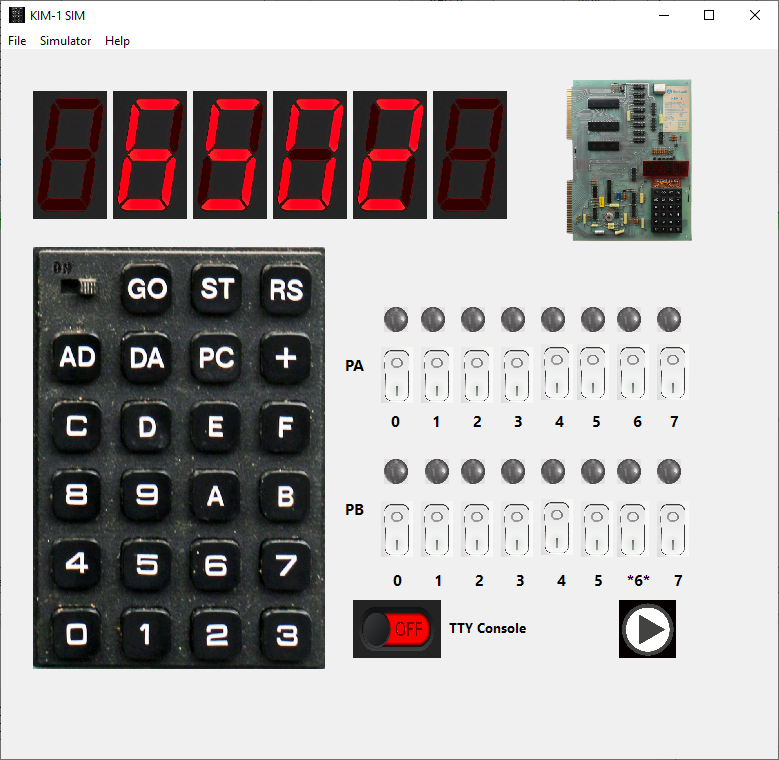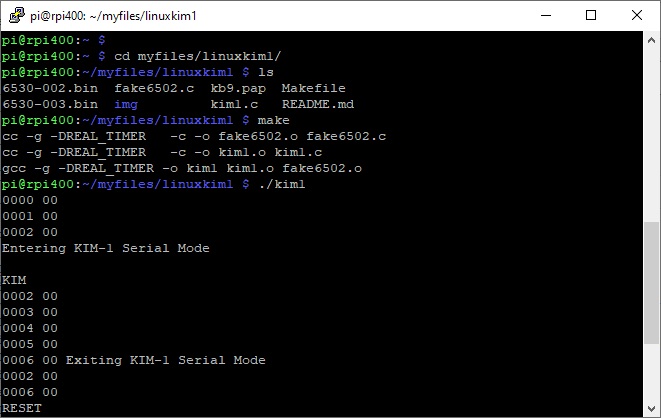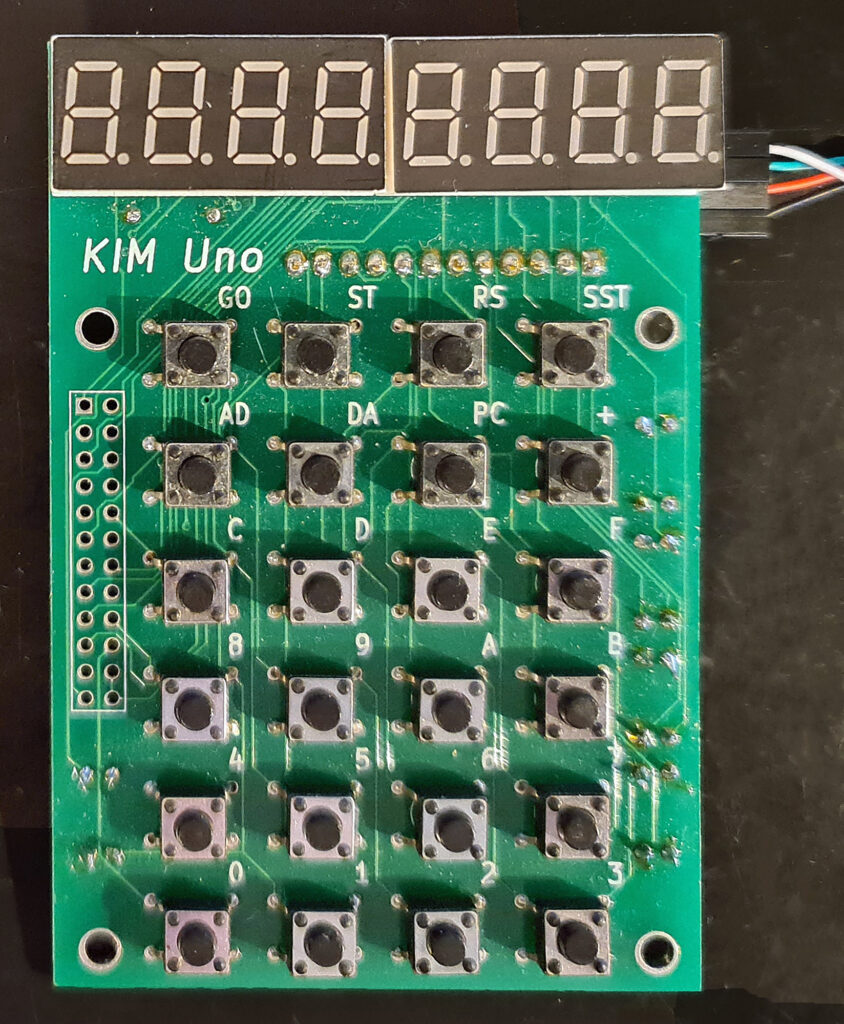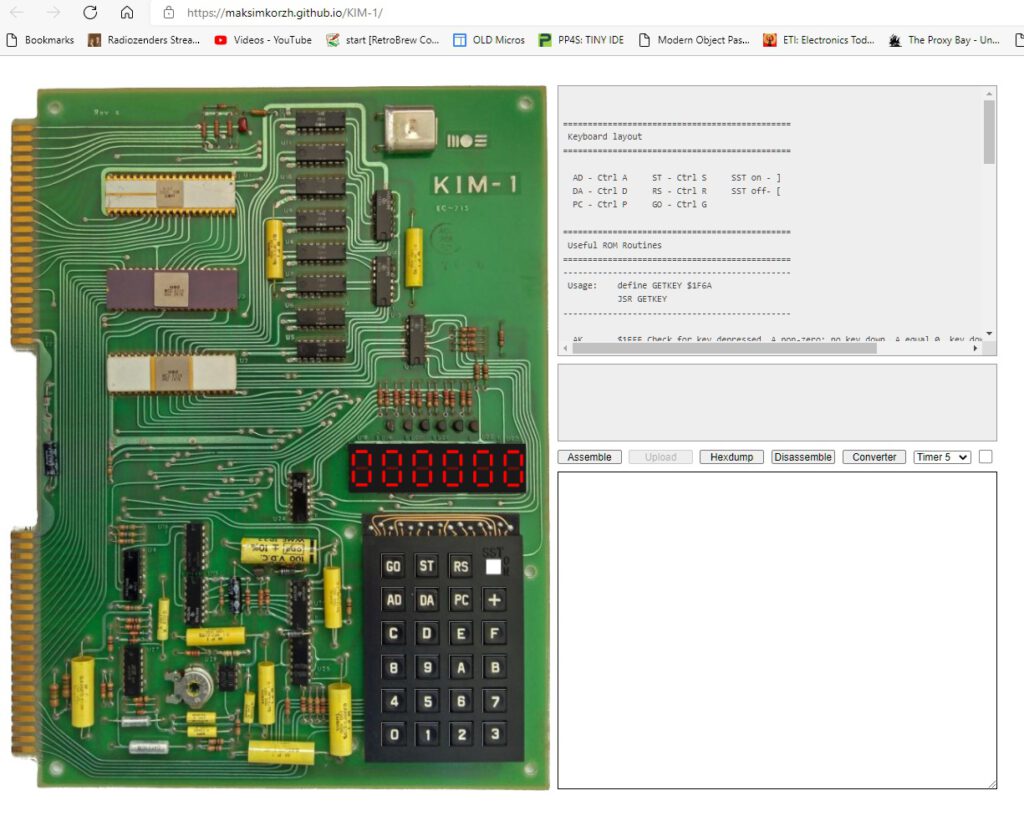A list of KIM-1 emulators/simulators
To be included in this list, the emulator should run the original KIM-1 ROM’s. I prefer to see source code, which all do except Kimplement. If I can not run it, it is not on this list (I know of an Apple iPhone and a Palm Pilot version) .
My favorites are of course my own KIM Simulator (for TTY programs) and the KIM-1 emulator in JavaScript (for LED display programs).
Troublemakers in KIM-1 emulation are due to the bit banging nature of the KIM-1 system:
- Serial I/O.
Since the KIM-1 uses bit banging to do serial I/O this is hard to emulate. Therefore most emulators patch the ROM at the GETCH and OUTCH locations to send and receive a character, including the hardware echo of GETCH - The automatic baudrate detection, also a bit banging routine, is patched out since it has no meaning with patched serial I/O routines and makes the emulator hang at boot.
- Break detection.
Most KIM-1 programs, like MS-Basic, break/stop detection by a BIT at location $1740. This of course does not work on patched serial I/O, so a patch at location 1740 is required. - The finer details of the serial interface, like PB0, PB5, PB7 and PB7 are often not implemented, so the hardware echo can not be prevented.
- Tape I/O, $1800, $1873, is often replaced by some form of dumping /loading memory with the start and stop and ID of the original routine with a binary file or omitted
- LED displays.
Also bit banging. By calling the SCANDS routine, repeated at a fast rate, the LED segments are switched on and off. The data, six nibbles interpreted as a hex number, per LED display comes from $F9, $FA, $FB, for a total of six digits. A bit complicated (see the information below) and hard to emulate without flickering.
A solution is to patch the SCANDS routine and displaying the hex without the switching off of segments. This works fine for the KIM-1 ROM itself and many programs that call SCANDS to light the LEDs. If the program (many First Book of KIM games e.g.) does bypass SCANDS and go directly to the hardware, it will fail.
Below is a list of, known to me, KIM-1 emulators/simulators. Details below the table.
| ——————— | ————- | ————- | —————— | ——– | |
| Name, website | Platform | Serial I/O | LED display | Tape | |
|---|---|---|---|---|---|
| ——————— | ————- | ————- | —————— | ——– | |
| KIM-1 Simulator | Windows, Linux, MacOS | terminal builtin | SCANDS emulation | None | |
| ——————— | ————- | ————- | —————— | ——– | |
| Linux terminal KIM-1 Emulator | Linux | CLI | CLI SCANDS emulation | Yes | |
| ——————— | ————- | ————- | —————— | ——– | |
| KIM-1 emulator in JavaScript | Web browser | No | Hardware emulation | None | |
| ——————— | ————- | ————- | —————— | ——– | |
| The Incredible KIMplement | C64 | Yes | Yes | ? | |
| ——————— | ————- | ————- | —————— | ——– | |
| KIM UNO | ARDUINO, ESP32, Windows, Linux | Yes | Yes | Yes | |
| ——————— | ————- | ————- | —————— | ——– | |
| VKIM | PALM OS (And HTML 5 browser, see VKIM | Yes | Yes | Yes | |
| ——————— | ————- | ————- | —————— | ——– |
KIM-1 Simulator
My own attempt to KIM-1 emulation. The goal is more to test and study 6502 software for the KIM-1 than cycle exact LED display KIM-1 emulation.
A GUI application. The LED display is simulated by patched SCANDS, so hex digits only, no LED games.
Serial TTY is fully supported including echo suppress and Break detection via the built-in glass teletype console.
Debugging mode allows full access tot the innards of the 6502 or 65C02, the KIM-1. memory view, single/multiple step, run to breakpoint, instruction logging,, cycle counter, disassembly.
Loading and saving to many common formats like MOS papertape, Intel Hex, Motorola S record, binary, hex.
Both RRIOTs, a 6850 ACIA, a LE/switch to the free RRIOT port, RAM to E000, a utility ROM at F000. Runs all known TTY programs.
Things not working yet: LED displays via hardware RRIOT ports (without flickering!), timers in RRIOTs, timed execution to 1 MHz, tape emulation (including the Micro ADE tape motor control support).
Linux KIM-1 emulator
A command line KIM-1 emulator, running on Linux. Runs fine on Raspberry Pi OS.
Simulates LED display with characters displayed at the terminal. Every key entered results in a new line with the LED display. Also supports TTY mode, be it limited to the maximum of 5K RAM in lower memory.
A good attempt to stay close to the bit banging nature of the keyboard entry routine. Limits speed to 1 MHz.
The Incredible KIMplement
A KIM-1 emulator running on a Commodore 64. Which means it will be slow, since 1 MHz 6510 running an emulated 6502, you get the picture. I did test run/Kimplement a long time ago in an C64 emuatator, The Incredible KIMplement is a KIM-1 emulator for the Commodore 64 (yes, this is not a joke — see the screenshot to the right). It is a true, partial emulation of the original KIM-1 hardware featuring:
- Powered by “6o6” — a full software NMOS 6502 emulation (documented opcodes only, sorry) with all addressing modes, simulated ROM, and simulated memory-mapped I/O
- LED and keypad emulation via partial RIOT emulation
- TTY emulation (ASR-33 subset) via partial RIOT emulation
- SST emulation
- 4K RAM expander card
- KIM-4 emulation with 8K RAM expander card (thus total address space 16K)
- Revision E ROMs built-in, so you don’t have to find a pirated set download them from your own KIM
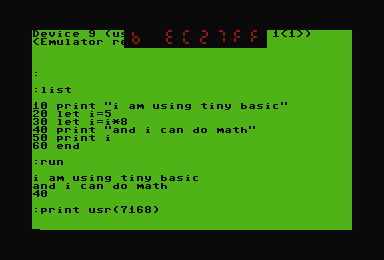
KIM UNO
The KIM Uno, designed and produced and sold by Oscar Vermeulen, is a very simple “open-source hardware” project that started out as a replica of the classic 1976 KIM-1 computer. Later, Apple-1 compatibility and a 6502 programmable calculator mode were added, plus a built-in ‘early 6502 software gems’ collection.
It costs about $10 in commonly available parts (board & parts without case or power supply), but provides a faithful KIM-1 ‘experience’. An Arduino Pro Mini mounted on the back contains all the logic and memory.
I have two versions: the ‘original’ and the later redesigned version, Software-wise the same, with on the top of the PCB room for power connector (GND, +5V or a 9V battery) and a slide switch. , I use them with an USB cable (the blue one of this page) for power and the serial interface provided.
The software already works on the blue pill STM32 or an ESP32, with manual cabling to the keyboard/display and I expect a new version of the PCB for the ESP32.
The software for the serial interface (you really need a good serial terminal emulator, like Minicom or Tera Term) can be used on any Arduino Uno. After power on it delivers a simulation of the LED display or the real KIM TTY teletype interface (a bit broken in the current version).
All well described on the pages of Oscar and well worth the money for a ‘6502 SBC’ experience or a Cosmac 1802 with a small LCD.
KIM-1 emulator in JavaScript
By Code Monkey King, web browser based, run it here.
Emulates the keypad/LED display part only. Hardware emulation of LED display. Emulates KIM-1 LED display very well!
Some handy tools like 6502 assembler, paper tape format converter and hexdump generator
No TTY, limited RAM.
Code on github
KIM-1 hardware information relevant to emulation
RAM ROM I/O
OVERVIEW OF KIM-1 MEMORY MAP fully extended (A-K connected!)
0000-1400 RAM
1600-1700 free, can be RAM or I/O or ROM
1700-173F I/O and timer of 6530-003
1700 Port A,
1701 DDR Port A
1702 Port B,
1703 DDR Port B
1704- timer
1740-177F I/O and timer of 6530-002, used by LED/Keyboard/tape
1740 Port A,
1741 DDR Port A
1742 Port B,
1743 DDR Port B
1744- timer
1780-17BF RAM from 6530-003 , free for user applications
17C0-17FF RAM from 6530-002 , free for user except 0x17E7-0x17FF
1800-1BFF ROM003
1C00-1FFF ROM002
emulator mirrors last 6 bytes of ROM 002 to FFFB-FFFF:
2000 - DFFF RAM in simulator
F000- ROM in simulator for patching KIM-1 ROM serial I/O and keypad
FFFA, FFFB - NMI Vector copy of KIM-1 ROM ROM002
FFFC, FFFD - RST Vector copy of KIM-1 ROM ROM002
FFFE, FFFF - IRQ Vector copy of KIM-1 ROM ROM002
| ADDRESS | AREA | LABEL | FUNCTION |
| | | | |
| 00EF | | PCL | Program Counter - Low Order Byte |
| 00F0 | | PGH | Program Counter - High Order Byte |
| 00F1 | Machine | P | Status Register |
| 00F2 | Register | SF | Stack Pointer |
| | Storage | | |
| 00F3 | Buffer | A | Accumulator |
| 00F4 | | Y | Y-Index Register |
| 00F5 | | X | X-Index Register |
| 1700 | | PAD | 6530-003 A Data Register |
| 1701 | Application | PADD | 6530-003 A Data Direction Register |
| 1702 | I/O | PBD | 6530-003 B Data Register |
| 1703 | | PBDD | 6530-003 B Data Direction Register |
| 1704 | | | 6530-003 Interval Timer |
| | Interval Timer | | (See Section 1.6 of |
| | | | Hardware Manual) |
| 170F | | | |
| 17F5 | | SAL | Starting Address - Low Order Byte |
| 17F6 | Audio Tape | SAH | Starting Address - High Order Byte |
| 17F7 | Load & Dump | EAL | Ending Address - Low Order Byte |
| 17F8 | | EAH | Ending Address - High Order Byte |
| 17F9 | | ID | File Identification Number |
| l7FA | | NMIL | NMI Vector - Low Order Byte |
| l7FB | | NMIH | NMI Vector - High Order Byte |
| l7FC | Interrupt | RSTL | RST Vector - Low Order Byte |
| | Vectors | | |
| 17FD | | RSTH | RST Vector - High Order Byte |
| l7FE | | IRQL | IRQ Vector - Low Order Byte |
| 17FF | | IRQH | IRQ Vector - High Order Byte |
| 1800 | | DUMPT | Start Address - Audio Tape Dump |
| | Audio Tape | | |
| 1873 | | LOADT | Start Address - Audio Tape Load |
| 1C00 | STOP Key + SST | | Start Address for NMI using KIM |
| | | | "Save Nachine" Routine (Load in |
| | | | 17FA & 17FB) |
| 17F7 | Paper Tape | EAL | Ending Address - Low Order Byte |
| 17F8 | Dump (Q) | EAH | Ending Address - High Order Byte |
KIM-1 hardware
PA SAD, SADD
PB SBD SBDD
PB0 TTY data out (can block hardware TTY echo)
PB1 - PB4 outputs led select via 74145 6 leds O4 -O9 on/off, keypad O0-O3
PB5 TTY/audio control (block/allow inputs)
can block TTY input and audio input
PB7 audio in/out
PA0-6 keypad + LED segments
PA7 TTY data in
74145
PB1 - PB4 to ABCD inputs
Outputs
O4 to O9 LED on U18 to U23
O0 to O3 to key rows
PB PB1 PB2 PB3 PB4
A B C D
00-01 0 0 0 0 00 O0 keyrow 0
02-03 1 0 0 0 01 O1 1
04-05 0 1 0 0 02 O2 2
06-07 1 1 0 0 03 O3 3
08-09 0 0 1 0 O4 LED enable U18
0A-0B 1 0 1 0 O5 U19
0C-0D 0 1 1 0 O6 U20
0E-OF 1 1 1 0 O7 U21
10-11 0 0 0 1 O8 U22
12-13 1 0 0 1 o9 U23
Inits
750 1E8C A2 00 INIT1 LDX #$00
751 1E8E 8E 41 17 STX PADD FOR SIGMA USE SADD
PAx is input
752 1E91 A2 3F LDX #$3F
753 1E93 8E 43 17 STX PBDD FOR SIGMA USE SBDD
3F = 00111111
PB0 - PB5 output, PB7 input
754 1E96 A2 07 LDX #$07 ENABLE DATA IN
755 1E98 8E 42 17 STX SBD OUTPUT
PB0 = 1 high TTY, stopbit
PB1 -PB2 high (keypad?)
PB5 low ; allow input
PB7 low : audio quiet
Print OUTSP
toggle PB0 via read SBD, AND $FE, OR $01 and write SBD, end with 1
** SUB TO DETERMINE IF KEY IS DEPRESSED OR
; CONDITION OF SSW KEY NOT DEPRESSED OR
805 ; TTY MODE A=0
806 ; KEY DEPRESSED OR KB MODE A NOT ZERO
807 1EFE A0 03 AK LDY #$03 3 ROWS
808 1F00 A2 01 LDX #$01 DIGIT 0
809 1F02 A9 FF ONEKEY LDA #$FF
810 1F04 8E 42 17 AK1 STX SBD OUTPUT DIGIT
via 74145 Start with digit 0, continue with next row
811 1F07 E8 INX GET NEXT DIGIT
812 1F08 E8 INX
813 1F09 2D 40 17 AND SAD INPUT SEGMENTS
and key pressed to A
814 1F0C 88 DEY
815 1F0D D0 F5 BNE AK1
816 1F0F A0 07 LDY #$07
817 1F11 8C 42 17 STY SBD
back to INITS state
818 1F14 09 80 ORA #$80
819 1F16 49 FF EOR #$FF
set high bit and inverse all
A=0 no key
820 1F18 60 RTS
822 1F19 A0 00 SCAND LDY #$00 GET DATA 1F19
823 1F1B B1 FA LDA (POINTL),Y SPECIFIED BY POINT
824 1F1D 85 F9 STA INH SET UP DISPLAY BUFFER
825 1F1F A9 7F LDA #$7F CHANGE SEG
826 1F21 8D 41 17 STA PADD TO OUTPUT
PA0 - PA6 output
827 1F24 A2 09 LDX #$09 INIT DIGIT NUMBER start with U18
828 1F26 A0 03 LDY #$03 OUTPUT 3 BYTES 6 hex numbers
829 1F28 B9 F8 00 SCAND1 LDA INL,Y GET BYTE
830 1F2B 4A LSR A GET MSD high byte
831 1F2C 4A LSR A
832 1F2D 4A LSR A
833 1F2E 4A LSR A
834 1F2F 20 48 1F JSR CONVD OUTPUT CHAR
835 1F32 B9 F8 00 LDA INL,Y GET BYTE AGAIN
836 1F35 29 0F AND #$0F GET LSD low byte
837 1F37 20 48 1F JSR CONVD OUTPUT CHAR
838 1F3A 88 DEY SET UP FOR NEXT BYTE
839 1F3B D0 EB BNE SCAND1
840 1F3D 8E 42 17 STX SBD ALL DIGITS OFF
X = 0?
841 1F40 A9 00 LDA #$00 CHANGE SEGMENT
842 1F42 8D 41 17 STA PADD TO INPUTS
PA0-PA7 inputs
843 1F45 4C FE 1E JMP AK GET ANY KEY
844 ; ** CONVERT AND DISPLAY HEX (USED BY SCAND ONLY)**
show character on LED
845 1F48 84 FC CONVD STY TEMP
846 1F4A A8 TAY SAVE Y
847 1F4B B9 E7 1F LDA TABLE,Y USE CHAR AS INDEX
848 1F4E A0 00 LDY #$00 LOOKUP CONVERSION
849 1F50 8C 40 17 STY SAD TURN OFF SEGMENTS
PA0-PA7 0
850 1F53 8E 42 17 STX SBD OUTPUT DIGIT ENABLE
X = LED number U18-U23 decimal to 74145
851 1F56 8D 40 17 STA SAD OUTPUT SEGMENTS
write segment from table to LED
852 1F59 A0 7F LDY #$7F DELAY 500 CYCLES
853 1F5B 88 CONVD1 DEY
854 1F5C D0 FD BNE CONVD1
855 1F5E E8 INX GET NEXT DIGIT NUMBER
856 1F5F E8 INX ADD 2
857 1F60 A4 FC LDY TEMP RESTORE Y
858 1F62 60 RTS
GETKEY > 15 ? no key
14 = PC
10 = addressmode
11 - Datamode
12 = step
13 = RUN
0 - F - hex digit
/* RIOT2 explanation: better emulation of LED display through simulated hardware rather than 2014's ROM patch
*
* The RIOT-002 chip is used to drive the LEDs, read the keypad, and control TTY and tape.
* KIM Uno only emulates the LED driver and timer hardware; the keypad, TTY and tape are emulated on a higher abstraction level in the ROM
*
* On the real KIM-1, the keyboard columns are PA0-PA6 and the rows are selected through
* the display columns are PA0-PA6 and the segment led is decoded from PB 0000 1110
* teletype mode is detected when = 1.
* teletype uses PB0, PB5, PA7
*
* 1740 Data port A Selects pattern to show on a segment LED (PA0-6) and TTY (PA7)
* 1741 Data Direction port A Are the GPIO pins set to input or output?
* 1742 Data port B Selects which of the 6 segment LEDs is lit up (PB1-3),
* and also: PB0 (TTY), PB4 ???, PB5 (TTY/tape input?), PB 6(RIOT internal, ChipSelect), PB7 (tape output)
* 1743 Data direction port B Are the GPIO pins set to input or output?
*/
void write1740(void) // ======== PA pins - set the individual LED segments on or off
{
//riot2regs.ioPAD &= 0x7F; // only the bits for the 7 LEDs in a segment LED
for (uint8_t ibit=0; ibit<7; ibit++)
digitalWrite(kCols[ibit], (riot2regs.ioPAD & (1<<ibit))==0); // set the bit, inverted through ==0
}
void write1741(void) // ======== Data direction register for PA
{
for (uint8_t ibit=0; ibit<7; ibit++)
if ( riot2regs.ioPADD & (1<<ibit) )
pinMode(kCols[ibit], OUTPUT); // set pin to output
else
pinMode(kCols[ibit], INPUT); // set pin to output
}
void write1742(void) // ======== PB pins - set which of the 6 segment LEDs is lit up
{
uint8_t led = ((riot2regs.ioPBD - 9) >> 1) & 0b111; // identify the selected segment LED
for (uint8_t iLed=0;iLed<6;iLed++) // set GPIO pins of all 6 KIM-1 LED segments
{ if (iLed==led)
digitalWrite(ledSelect[iLed], HIGH); // power up this segment LED
else
digitalWrite(ledSelect[iLed], LOW); // power down the other segment LEDs
}
}
void write1743(void) // ======== Data direction register for PB
{
// TEMP: all LED pins are set to output; there's no functionality we need except that.
for (uint8_t iLed=0;iLed<6;iLed++)
pinMode(ledSelect[iLed], OUTPUT);
}
} // end of C segment

